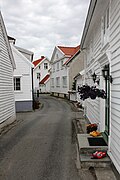
Vest-Agder was one of 18 counties (fylker) in Norway up until 1 January 2020, when it was merged with Aust-Agder to form Agder county. In 2016, there were 182,701 inhabitants, around 3.5% of the total population of Norway. Its area was about 7,277 square kilometres (2,810 sq mi). The county administration was located in its largest city, Kristiansand.

Lindesnes is a municipality in Agder county, Norway. It is located in the traditional district of Sørlandet. The administrative centre of the municipality is the town of Mandal. Other villages in Lindesnes include Åvik, Høllen, Skofteland, Svenevig, Vigmostad, Heddeland, Bjelland, Breland, Koland, Laudal, Øyslebø, Bykjernen, Skjebstad, Sånum-Lundevik, Skogsfjord-Hesland, Krossen, Harkmark, Skinsnes-Ime, and Tregde-Skjernøy.

Flekkefjord is a municipality in Agder county, Norway. It is located in the traditional district of Lister. The administrative centre of the municipality is the town of Flekkefjord. The villages of Sira, Gyland, Rasvåg, Kirkehavn, and Åna-Sira are located in Flekkefjord.
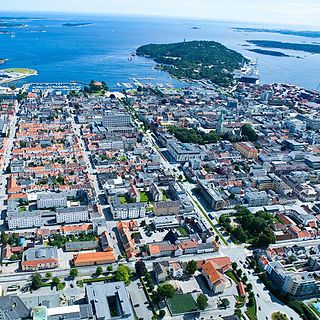
Kristiansand is a city and municipality in Agder county, Norway. The city is the fifth-largest and the municipality is the sixth-largest in Norway, with a population of around 116,000 as of January 2020, following the incorporation of the municipalities of Søgne and Songdalen into the greater Kristiansand municipality. In addition to the city itself, Statistics Norway count four other densely populated areas in the municipality: Skålevik in Flekkerøy with a population of 3,526 in the Vågsbygd borough, Strai with a population of 1,636 in the Grim borough, Justvik with a population of 1,803 in the Lund borough, and Tveit with a population of 1,396 in the Oddernes borough. Kristiansand is divided into five boroughs; -Grim, which is located northwest in Kristiansand with a population of 15,000; Kvadraturen, which is the centre and downtown Kristiansand with a population of 5,200; Lund, the second largest borough; Søgne, with a population of around 12,000 and incorporated into the municipality of Kristiansand as of January 2020; Oddernes, a borough located in the west; and Vågsbygd, the largest borough with a population of 36,000, located in the southwest.
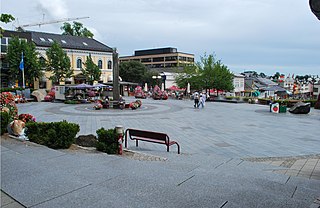
Larvik is a municipality in Vestfold county, Norway. It is located in the traditional district of Vestfold. The administrative centre of the municipality is the city of Larvik. Other main population centres in the municipality include the town of Stavern and the villages of Gjone, Helgeroa, Hem, Kjose, Kvelde, Nevlunghavn, Skinmo, Svarstad, Ula, Verningen, and Tjøllingvollen.

Lillesand is municipality in Agder county, Norway. It is part of the traditional district of Sørlandet. The administrative center of the municipality is the town of Lillesand. Some of the larger villages in Lillesand municipality include Åkerøyhamn, Brekkestø, Gamle Hellesund, Helldal, Høvåg, Ribe, Skottevik, Trøe, Ulvøysund, and Vesterhus.

Southern Norway is the geographical region (landsdel) along the Skagerrak coast of southern Norway. The region is an informal description since it does not have any governmental function. It roughly corresponds to the old petty kingdom of Agder being coextensive with the county, as well as the two former counties of Vest-Agder and Aust-Agder. From New Year 2020, the two counties have been merged into one county, Agder. The total combined area of Vest-Agder and Aust-Agder counties is 16,493 square kilometres (6,368 sq mi). The name is relatively new, having first been used in Norway around 1900.

Kopervik is the largest town on the island of Karmøy in Rogaland county, Norway. It is also the administrative centre of the municipality of Karmøy. It is part of the traditional district of Haugaland. The town was also an independent municipality from 1866 until 1965.
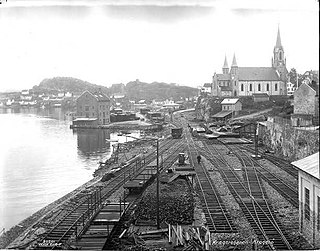
The Kragerø Line was a 27-kilometer (17 mi) long railway line between Neslandsvatn and Kragerø in Telemark county, Norway. It was opened on 2 December 1927 as part of the Sørlandet Line. From 10 November 1935, the Sørlandet Line was extended from Neslandsvatn to Arendal, and the Kragerø Line became a branch. It was mostly served with feeder trains, although a through train to Oslo was kept until the 1970s. Falling ridership caused the line to become closed from 1 December 1989, along with many other branch lines. Part of the line remains, although other parts have been demolished.

Nes og Hitterø or Hitterø og Nes is a former municipality that was located in the old Vest-Agder county in Norway. It was located in the southwestern part of the present-day municipality of Flekkefjord in Agder county. It encompassed the Nes peninsula and the island of Hidra. The 240-square-kilometre (93 sq mi) municipality existed from 1838 until its dissolution in 1893. The administrative centre of the municipality was the small village of Sunde in Nes parish, located just outside the town of Flekkefjord.

The Flekkefjord Line is a 17.1-kilometre (10.6 mi) abandoned branch line to the Sørland Line. It ran between Sira and Flekkefjord in Agder, Norway. The only current activity on the line is tourist draisines. The station buildings along the line were designed by the architect Paul Armin Due—these have all been demolished.
A kjøpstad is an old Scandinavian term for a "market town" in Denmark–Norway for several hundred years. Kjøpstads were places of trade and exporting materials. Towns were given the "dignity" or rank of being referred to as a kjøpstad when they reached a certain population. They had an established means of industry and other notable items, such as dockyards, steam mills, forges, churches, and grammar schools. The citizens of a kjøpstad could buy and sell goods and conduct other economic activities.
Cornelius Bernhard Hanssen was a Norwegian teacher, shipowner and politician for the Liberal Party.
Sivert Hanssen-Sunde was a Norwegian politician.

is the administrative centre of Farsund municipality in Agder county, Norway. The town is located near the mouth of the Lyngdalsfjorden, about 5 kilometres (3.1 mi) east of the village of Vanse. Frelserens Church is the main church for the town. The 2.96-square-kilometre (730-acre) town has a population (2019) of 3,377 and a population density of 1,140 inhabitants per square kilometre (3,000/sq mi). In Norway, Farsund is considered a by which can be translated as either a "town" or "city" in English.
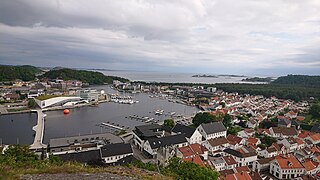
Mandal is a town in Lindesnes municipality in Agder county, Norway. Mandal is the fourth largest town in Agder as well as the administrative centre of Lindesnes municipality. It is located at the mouth of the river Mandalselva at the southern end of the Mandalen valley. The 6.63-square-kilometre (1,640-acre) town has a population (2019) of 11,053 and a population density of 1,667 inhabitants per square kilometre (4,320/sq mi). In Norway, Mandal is considered a by which can be translated as either a "town" or "city" in English.
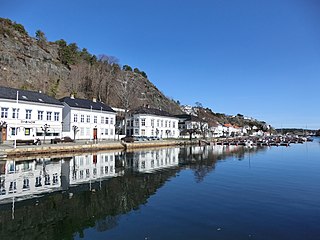
Risør is a Seaside resort, a town and the administrative centre of Risør municipality in Agder county, Norway. The town is located along the Skagerrak coast on a peninsula between the entrances to the Søndeledfjorden and the Sandnesfjorden. The town is one of the oldest towns in Southern Norway. It was declared a ladested in 1630 and upgraded to a kjøpstad in 1723. It sits about 20 kilometres (12 mi) southwest of the nearby coastal town of Kragerø and about the same distance northeast of the nearby coastal town of Tvedestrand. The nearest large town to Risør is the town of Arendal, about 40 kilometres (25 mi) to the southwest. The 2.92-square-kilometre (720-acre) town has a population (2019) of 4,609 and a population density of 1,580 inhabitants per square kilometre (4,100/sq mi).

Grimstad is a town in Grimstad municipality in Agder county, Norway. The town is also the administrative centre of the municipality. It is located on the Skaggerak coast in Southern Norway along the Groosefjorden, between the towns of Arendal and Lillesand. The 10.02-square-kilometre (2,480-acre) town has a population (2019) of 13,543 and a population density of 1,352 inhabitants per square kilometre (3,500/sq mi). In Norway, Grimstad is considered a by which can be translated as either a "town" or "city" in English.

Arendal is a city in Agder county, Norway. The city is the administrative centre of the municipality of Arendal and the seat of the County Governor of Agder. The city also includes a small area in the neighbouring municipality of Grimstad as well. In Norway, Arendal is considered a by which can be translated as either a "town" or "city" in English.






